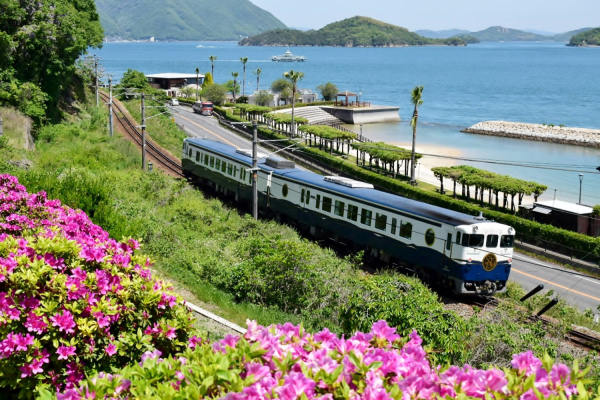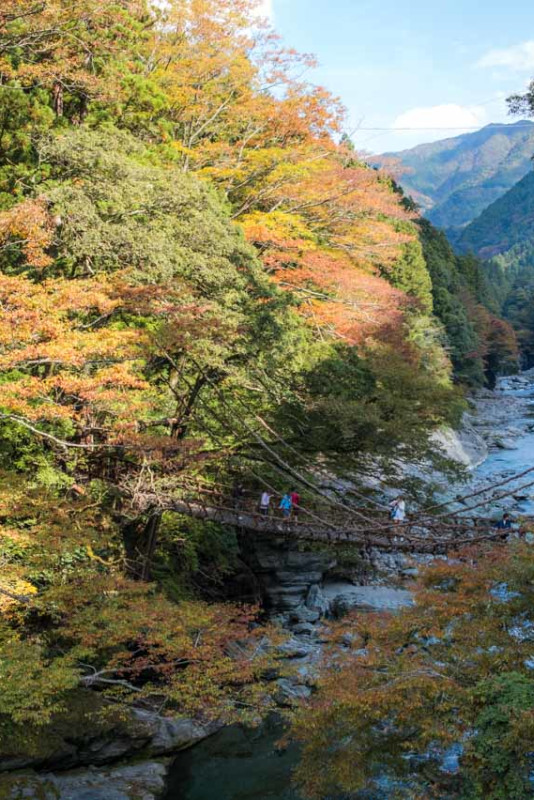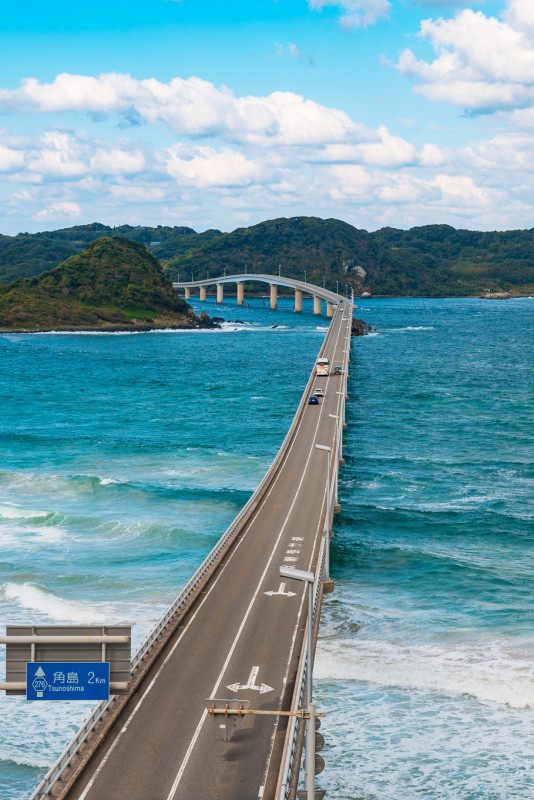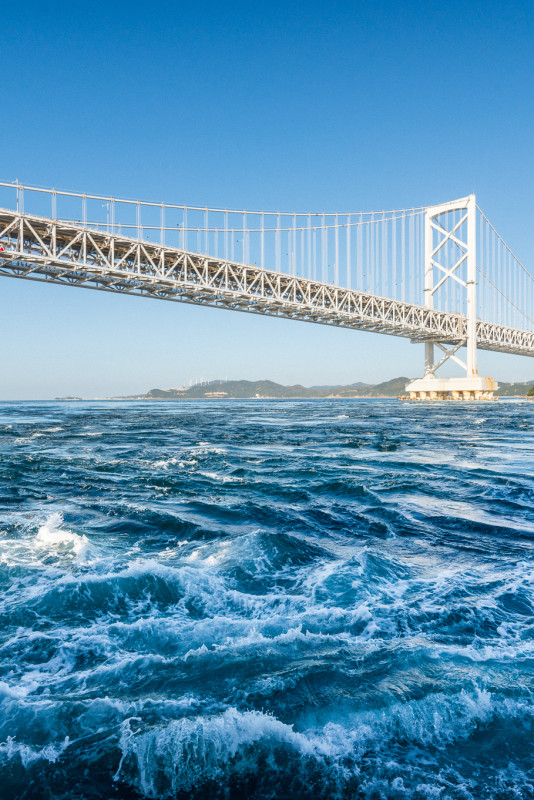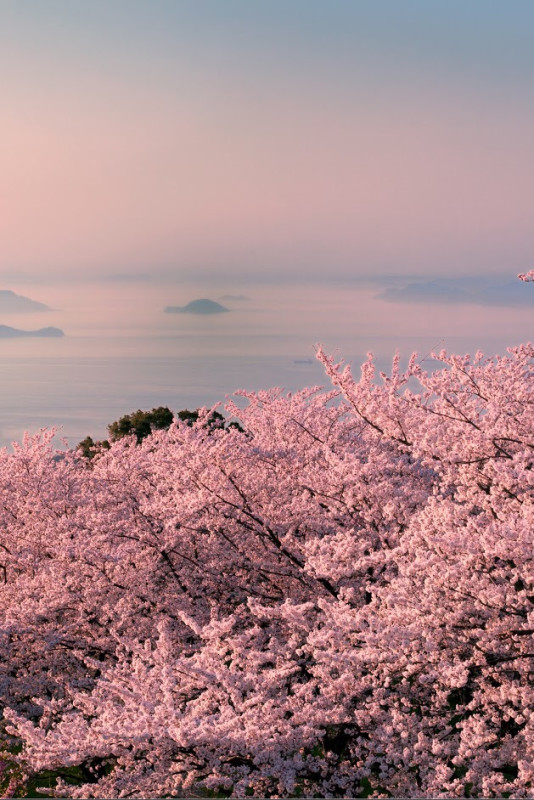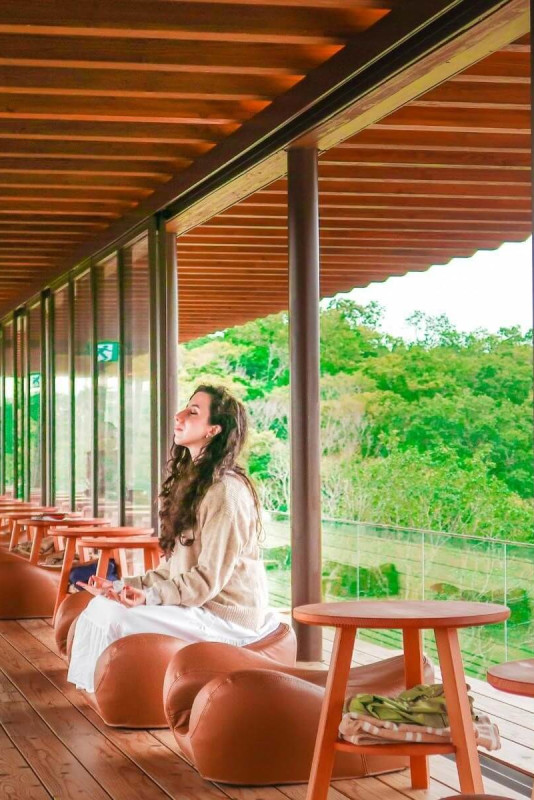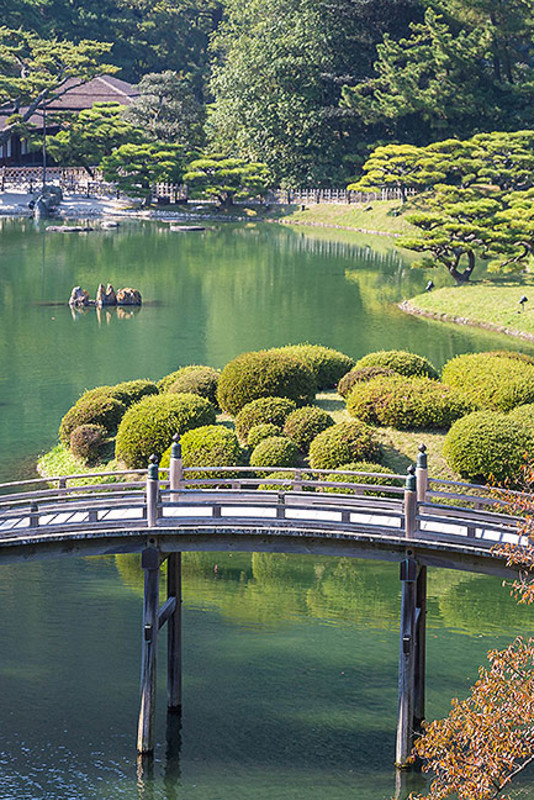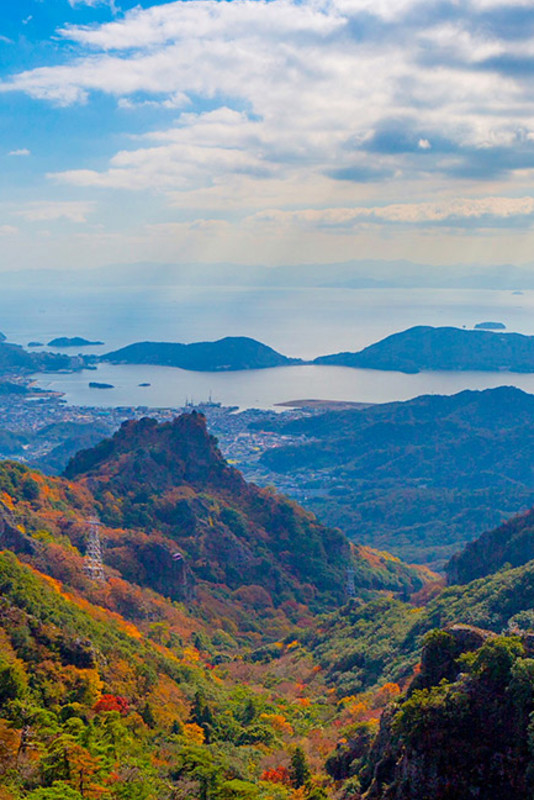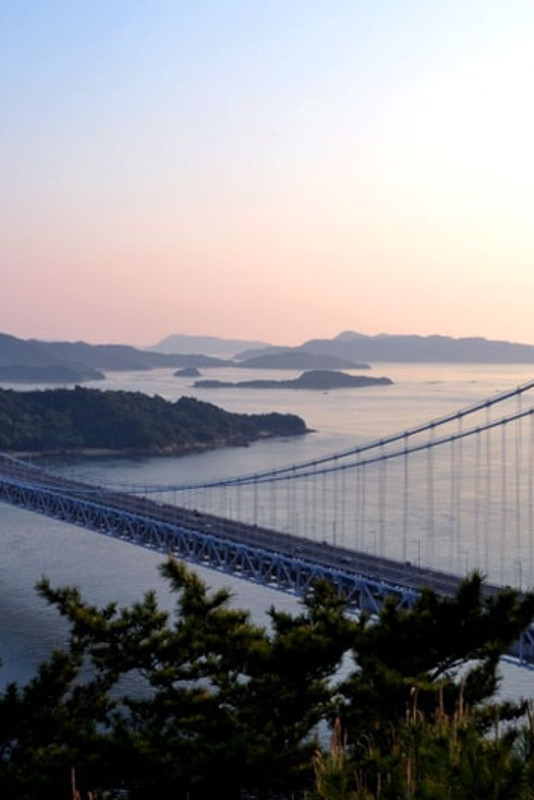Itineraries
Four Days Exploring the Culture and Nature of Eastern Setouchi

Experience the traditions and culture of Setouchi and savor its beautiful scenery as you travel through the region. This itinerary will take you from Tokushima, home of indigo dyeing and energetic Awa dance, to the idyllic Iya Valley. After your stay in a renovated farmhouse in an unmatched location, you will continue to the gardens of Takamatsu and Okayama.
- Day 1: Tokushima and Naruto
- Tokushima and Naruto
Travel: Osaka to Tokushima
The most direct route to Tokushima from Osaka is crossing Awaji Island via the Akashi Kaikyo Bridge by car or bus. You can also take the train to Tokushima via Okayama and the Seto Ohashi Bridge (Approx 2 hours 30 minutes).
Dance the Awa Odori at the Awa Odori Kaikan
The Awa Odori is a festive dance famous for its energy and high-tempo music. The dance originated in Tokushima and every August over a million revelers attend the city’s Awa Odori Dance Festival, making it one of the biggest festivals in Japan. Whatever the time of year, you can visit the Awa Odori Kaikan Hall to see live dance performances and take to the stage yourself to learn the Awa Odori from the professionals.
Tokushima Prefectural Awa Jurobe Yashiki (Puppet Theater and Museum)
This beautiful puppet theater puts on daily traditional Japanese puppet performances from March through to December. The theater also houses a permanent exhibition where you can learn all about this traditional Japanese performing art with its roots in Tokushima and neighboring Awaji. The theater itself is set within the grounds of the former residence of Bando Jurobe, a historical figure and the inspiration for the popular puppet play Keisei Awa no Naruto.
Otani Ware Ceramics
Otani ware pottery, developed 240 years ago using a special clay extracted from the Sanuki Mountains, is renowned for its rustic designs and slightly metallic finish. Originally used to store the region’s famous indigo dye, one of the unique characteristics of Otani-ware is how the larger pots are crafted. Known as nerokuro, one artisan lies on the ground and turns the pottery wheel with their feet while another artisan handles the clay. More recently, artisans have turned their hand to creating tableware. Visit Onishi Toki ceramics studio for the chance to buy some fine examples of Otani-ware pottery. In Tokushima City, Otani pottery is also available at Tokushima Prefectural Souvenir and Tourism Plaza and O-ba’sh Cafe serves its food on stylish, modern Otani ware.
Naruto Whirlpool Cruise
The Seto Inland Sea sees two huge tidal shifts each day. In the Naruto Strait, the tidal water is funneled through a narrow channel, which creates the famous Naruto whirlpools. Although you can see the whirlpools from the bridge, going on a whirlpool cruise is by far the best way to get up close to these iconic eddies. There are a number of different cruise operators running out of Naruto and they adjust departure times to match the tidal changes.
Accommodation: Hotel Ridge
Stay overnight at the Hotel Ridge, a secluded wellness resort with stunning views of the Naruto whirlpools and the Naruto Ohashi Bridge. Everything at Hotel Ridge has been curated to make your stay as relaxing as possible. The hotel suite’s minimalist design and unobstructed views of the Seto Inland Sea all add to the general feeling of serenity. At dinner, the attention to detail in the presentation of the kaiseki meal will take your breath away. Treat your tastebuds to an ensemble of fresh seasonal ingredients. Along with their natural hot spring spa, Hotel Ridge offers guests thalassotherapy massages and treatments that harness the soothing properties of the sea.
URL: https://hotelridge.jp
- Day 2
- Wakimachi and Iya Valley
Travel: Naruto to Wakimachi Town
・Take the train or bus from Naruto Station to Tokushima Station (Approx 40-50 minutes)
・Take the Tsurugisan Limited Express train from Tokushima Station to Anabuki Station (Approx 40 minutes)
・Wakimachi is 10 minutes by taxi from Anabuki Station.
Explore Wakimachi Udatsu Street and Try Aizome Indigo Dyeing
The town of Wakimachi was the heart of Tokushima’s aizome indigo dyeing industry during the Edo period (1603-1868).
Tokushima (formerly known as Awa) has been a center of indigo dye production for around 800 years. The land, well-irrigated by the Yoshino River, is ideal for growing the indigo plant (ai) from which the natural dye is extracted. Demand was ensured by a statute that Indigo blue was one of the few colors samurai were allowed to wear during the Edo period (1603-1868). As techniques improved Awa-ai became renowned for its quality and merchants in towns like Wakimachi prospered.
The historical Udatsu Street in the center of the town is an illustration of the wealth the industry generated. Udatsu is the name given to the earthen firebreaks fixed between the houses, but here in Wakimachi they also served as ornate signifiers of wealth. Walking the streets of Wakimachi is a delight as many of the period buildings have been beautifully preserved and restored.
You can try your hand at indigo dyeing yourself at the Mima-shi Kankokoryu Center. You can dye and create patterns on your very own indigo handkerchief and browse other aizome products for sale in the shop.
Travel: Wakimachi to Iya Valley
・It takes between 1 and 2 hours by train (with a change in Awa Ikeda) to travel from Anabuki Station to Oboke Station, the gateway to the Iya Valley.
・Taxis or rental cars are recommended when traveling around Iya Valley.
Accommodation: Tougenkyo-Iya
Tougenkyo-Iya is a collection of eight pristine Japanese thatched roof farmhouses in the mountain village of Ochiai in Higashi-Iya. This is the quintessential Japanese “satoyama” landscape where village life and nature overlap and cohabit the same space. The houses, built on the mountain during the Edo period (1603-1868), have been beautifully renovated to allow guests to experience traditional Japanese country living in comfort.
All the houses look out at the beautiful valley below and you have the option of catered meals with local dishes prepared for you by locals. Tougenkyo-Iya goes beyond the usual vacation lodging. Staying here will give you a chance to discover the essence of Japanese life and culture.
URL: https://www.tougenkyo-iya.jp/reservation/
- Day 3
- Yoshino River and Takamatsu
White Water Rafting in Oboke Gorge
Carved out of the Shikoku Mountains over 200 million years by the Yoshino River, Oboke Gorge and Koboke Gorge is the destination of choice for travelers looking to encounter Japan’s great outdoors. You have different options on how to explore this stunning natural landscape. Aside from hiking through its trails and forests, the Oboke Gorge Sightseeing Pleasure Boat can take you upstream and show you the gorge from the water.
For the more adventurous, you can find white water rafting operators along the Yoshino River. This river is regarded as one of the best white water rafting locations in the world – so much so they staged the 2017 World Rafting Championships on the river. For over ten years, Happy Raft, founded by experienced Australian rafter Mark Treston, has been guiding visitors through the rapids and offering other exotic gorge-based activities like canyoning. Along the gorge, you will find wonderful viewpoints offering breathtaking views of the area. If you are lucky with the weather conditions, you might witness the sea of clouds (unkai) that can form in the valley below.
Travel: Iya Valley to Takamatsu
If traveling on public transport, take a bus or taxi to Oboke Station and take a JR Limited Express service to Takamatsu. The journey takes between approx 1 hour and 30 minutes and 1 hour and 45 minutes.
Shikoku Mannaka Sennen Monogatari
If you want to travel in style, board the Shikoku Mannaka Sennen Monogatari. This scenic train offers a more leisurely approach to seeing the beauty of the Shikoku countryside and majesty of the Oboke Gorge. The beautifully designed train runs from Tadotsu and offers a fine selection of season on-board meals with ingredients sourced from the region.
URL: https://www.jr-eki.com/global/en/travel/sennen_top/index.html?_gl=1*jsv3rr*_ga*MTg2NTgxMDYzNy4xNjQ0ODE4MzIx*_ga_K0B5H69NMS*MTcwNzM1NTE4MC4yMzIuMC4xNzA3MzU1MTgwLjAuMC4w
Ritsurin Garden
Enjoy traditional Japanese tea and a tranquil boat ride in Takamatsu’s world-renowned 400-year-old Ritsurin Garden. Famous for its picture postcard views and hundreds of well-manicured pine trees, Ritsurin Garden is designated as a Special Place of Scenic Beauty and received a glowing three-star review in the Michelin Green Guide Japan.
Bonsai at Takumikumo in Kinashi Town
After wandering among the pine trees of Ritsurin Garden, check out some in miniature in the nearby town of Kinashi. Takamatsu is said to produce 80% of Japan’s bonsai pines and Kinashi Town is the home of Takamatsu Bonsai. Nakanishi Chinshoen’s fifth generation-owner Yoichi Nakanishi is keen to help visitors interact with bonsai to learn more about this age-old craft. At Takumikumo Village, visitors can explore a forest of exquisite bonsai trees and leave with a newfound understanding of the philosophy, skill and patience needed to create these living masterpieces.
2.5 hour tour of the gardens and nursery, led by a bonsai master, followed by your choice of cultural experience (choose from creating your own bonsai moss ball, trying kintsugi golden joinery, making wagashi sweets, lacquerware or uchiwa fans) are available with 2 weeks advance notice.
Beautifully prepared lunches and dinners, using seasonal ingredients and served on artisanal tableware can also be arranged for groups of 4 people or more (Halal, vegetarian, vegan options also available) with 2 weeks advance notice.
URL: https://v.takumikumo.com
Sanuki Udon and Grilled Chicken on the Bone
Sanuki udon noodles is the go-to dish for locals and Kagawa Prefecture is known throughout Japan as the "Udon Prefecture." People travel from around the country to sample these noodles and you will see long lines outside the most popular restaurants.
Hone-tsuki-dori (grilled chicken thigh on the bone) is another local specialty. You can find restaurants offering variations of this dish throughout the region. The dish was created around 60 years ago when a local restaurateur was inspired by actors eating chicken on the bone in old Hollywood films.
Accommodation: Auberge de Oishi
Auberge de Oishi is a combination of luxurious accommodation with unbeatable views of the Setouchi and one of most acclaimed French restaurants in the region. Based on the concept of a French inn where people would travel and stay overnight to dine in comfort, Auberge de Oishi offers both high quality cuisine and spectacular lodgings. The chef who studied in France uses the finest ingredients from across the Setouchi and Japan for his authentic creations.
The rooms are stunning concrete structures reminiscent of Tadao Ando’s architecture and all the rooms come with high ceilings and breathtaking views of the Seto Inland Sea. Everything about Auberge de Oishi has the look and feel of a luxurious retreat. Any stay at Auberge de Oishi will leave you feeling completely rejuvenated.
URL: https://www.auberge-de-oishi.jp
- Day 4
- Okayama and Imbe
Travel: Takamatsu to Okayama
・Take the JR Line from Takamatsu Station to Okayama (Approx 50 minutes)
Okayama Castle and Korakuen Garden
Okayama Korakuen Garden in central Okayama is considered to be one of the three great Japanese gardens. Built around 300 years ago on the order of the feudal lord Ikeda Tsunamasa, the garden was designed as a “strolling garden” where the view shifts and changes as you walk around. Okayama Castle, located across the river from the garden, is known as “Ujo” or “crow castle” due to its striking, black-paneled exterior. Take your time to explore the castle interior and the grounds. The area around Okayama Korakuen Garden and Okayama Castle is an oasis of calm in the heart of Okayama City.
Okayama Kakushi Sushi
This traditional dish emerged in response to an ordinance issued by a local lord restricting meals to "one soup and one side dish." To circumvent the decree, an abundant assortment of fish and seasonal vegetables were heaped atop sushi rice, to create an opulent dish that could still technically be described as a single side dish. Not only visually stunning, kakushi sushi also has a delectable flavor profile. Each bite is a symphony of textures and tastes, as the freshness of the fish and the crispness of the vegetables mingle with the subtle tang of the vinegar-infused rice.
Japanese Restaurant Kibizen in Okayama maintains the tradition and offers authentic kakushi sushi. On first appearance, the wooden box appears to be just a layer of rice and finely shredded egg. However, flip the box upside down and you will reveal a hidden layer of delicious seasonal sashimi. The traditional dipping sauce made from pickled plums boiled in sake and dashi adds another layer of authenticity to the dish.
Travel: Okayama to Imbe Station
・Take the local train from Okayama Station to Imbe Station (Approx 40 minutes)
Bizen Pottery Experience in Imbe
Bizen pottery has a history stretching back over a thousand years, making it one of the most culturally important examples of pottery in the country. Bizen pottery does not use any glaze during the firing process. Instead, the raw, rustic appearance of the ceramics is part of the appeal. The Tokeido Pottery Workshop in Imbe has been producing pottery for over 500 years. This is the place to go for pottery workshops and to see authentic examples of Bizen pottery to buy as souvenirs.





































































